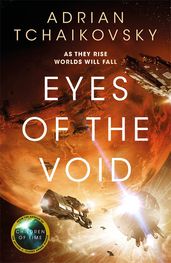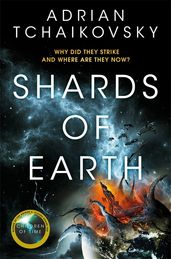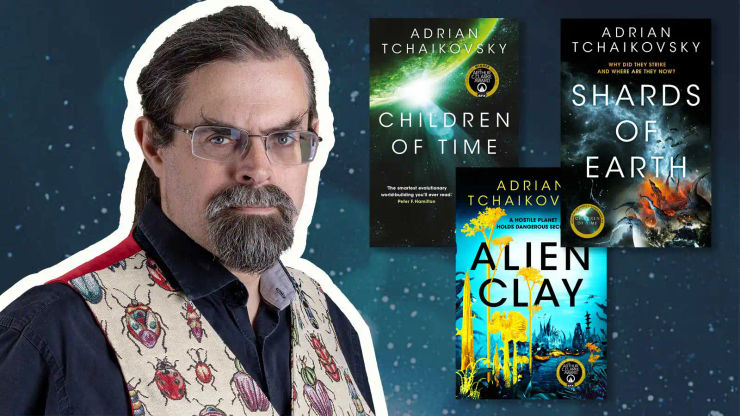Adrian Tchaikovsky's Shards of Earth Universe
"Building the world by destroying the Earth."
Legendary SFF writer Adrian Tchaikovsky introduces us to his brand new universe, and reveals his award-winning process behind complex world creation.

Winner of the Arthur C. Clarke award, Adrian Tchaikovsky is a master worldbuilder. His breakout epic Children of Time portrays the rise of a sentient spider species in mind-bending detail, and his 10-book fantasy series Shadows of the Apt immerses readers into the world of the Insect-kinden. He has since kickstarted a space opera series with Shards of Earth, where mysterious spacefaring 'Architects' rework planets into strange cosmic sculptures, decimating populations in the process. Here, he describes the universe of the Architects, his worldbuilding process, and how he imagined re-inventing the first-contact genre.
Looking for more? Discover Adrian Tchaikovsky's books in order.
At the start of Shards of Earth – actually, over a century before the book even begins - Earth has a very bad day. A moon-sized crystalline entity turns up and reworks the entire planet into a complex artistic statement and almost everyone dies. Thus starts spaceborne humanity’s war with the Architects. A war consisting entirely of a rearguard action as humans and their allies fight for time to evacuate whichever colony an Architect has appeared over on its murderously creative mission.
The universe of The Final Architecture is a lot broader than the merely human elements, but the scars left by the war are absolutely central to the books. All the human characters are the people they are because the war was what they lived through, or what their parents lived through. The same goes for many non-humans, such as the mechanical Hivers that were constructed as war tools by humans before a hard-won independence.
Idris the Intermediary is an un-aging, unsleeping survivor of the fighting, his brain twisted by surgical and chemical treatments. He was made as a weapon and persists as a commodity, and just wants to escape the notice of anyone who might want to stake a claim to him. Solace, warrior of the breakaway Parthenon, is a genetically engineered super-soldier whose people led the charge in the war, sacrificing themselves in countless battles. Now she’s woken from a frozen sleep into a world fifty years after the war’s end when her culture is at daggers drawn with mainstream humanity. The dissonance of the way things were and the way things are is wrenching for her. But even beyond these two actual veterans, the fact of the war casts a shadow over everyone.
‘When I write, I always start with the setting. Not plot, not characters, they all come later. For me, the joy of science fiction and fantasy lies in the unbounded possibilities of where a story begins and where it might take the reader. ’
The spacers – those who live on ships and on the busy fringes of the human Colonies – are the inheritors of a time when the whole human race lived with a packed bag and a pre-planned route to the nearest spaceport, because you never knew where the Architects would appear next. Characters like Olli and Rollo come from a tradition where everyone learns how to fix a spaceship because a spaceship is a home you can escape on, and you can’t trust planets any more. Kris comes from a settled world that grew its own weird and combative traditions as a way of facing the extermination that might come for them at any time. The menacing Piter Uskaro, noble scion, inherited power and prestige from the misfortunes of others in the war. The Uskaros are a powerful family who took in plenty of refugees fleeing the Architects, and now hold countless families in serfdom, slaving for the benefit of a new hereditary aristocracy.
Elsewhere, whole human colonies gave themselves into the control and worship of the alien Essiel, solely because those enigmatic aliens boasted a means to ward a world against the Architects’ intentions. Even at the start of the book, with the war a generation in the past, human worlds are still defecting because some people don’t believe the Architects are gone. Others are convinced that the end of the war was a sham. The history books (and Idris) attest that human Intermediaries made a first and final contact with the Architects, in the wake of such revelation the vast entities simply… vanished away. The Betrayed faction, however, claim the war could have been won by indomitable human spirit, but instead humanity was undermined and sold out by its leaders, by the Parthenon, by aliens, by anyone they can pin the blame on, refusing to accept how close humanity came to extinction.
When I write, I always start with the setting. Not plot, not characters, they all come later. For me, the joy of science fiction and fantasy lies in the unbounded possibilities of where a story begins and where it might take the reader. The process is a lot like throwing a stone into a pool and seeing where the ripples go. In this case, the stone is the Architects repurposing the Earth as sculpture.
It might seem odd not to take that actual event as the kicking-off point for the plot, to be honest – surely that’s where the drama is? Except the Big Alien War story gets told a lot, with varying levels of power differential and humans as victim/aggressor. More interesting, to me, to wind time forwards until after the war has gone, and a whole generation of people have grown up who never saw an Architect with their own eyes. What does that legacy do to people – those who are still haunted by it, those who angrily reinvent it? Those whose interest is to promote the threat of an enemy now consigned to history, and those for whom the past must be minimised and reinterpreted.
And what happens to all of these individuals and actions and subcultures when there’s a suggestion that the Architects are back? Just enough time has elapsed to sabotage all the careful planning of the wartime generation, to alienate humanity from its allies, to fracture what was once unified. The perfect storm.
Eyes of the Void

Thoughtful, inventive and high octane, Eyes of the Void is the second instalment of Adrian Tchaikovsky's Final Architecture space opera trilogy. Following eighty years of shaky peace, the alien enemy is back, conducting a terrible one-sided battle and consuming entire planets. Nobody is safe, and the Human Colonies are in chaos. As the threat grows ever closer, Idris has the chance to turn the tide for humanity. But to do so, he must face his demons in unspace. And what he finds there will change everything . . .
Shards of Earth
by Adrian Tchaikovsky
Idris has neither aged nor slept since they remade his mind in the war. And one of humanity’s heroes now scrapes by on a freelance salvage vessel, to avoid the attention of greater powers. Eighty years ago, Earth was destroyed by an alien enemy, killing millions. So mankind created enhanced humans such as Idris - who could communicate mind-to-mind with our aggressors. Then these ‘Architects’ simply disappeared and Idris and his kind became obsolete.
Now, Idris and his crew have something strange, abandoned in space. It’s clearly the work of the Architects – but are they really returning? And if so, why? Hunted by gangsters, cults and governments, Idris and his crew race across the galaxy as they search for answers. For they now possess something of incalculable value, and many would kill to obtain it.



